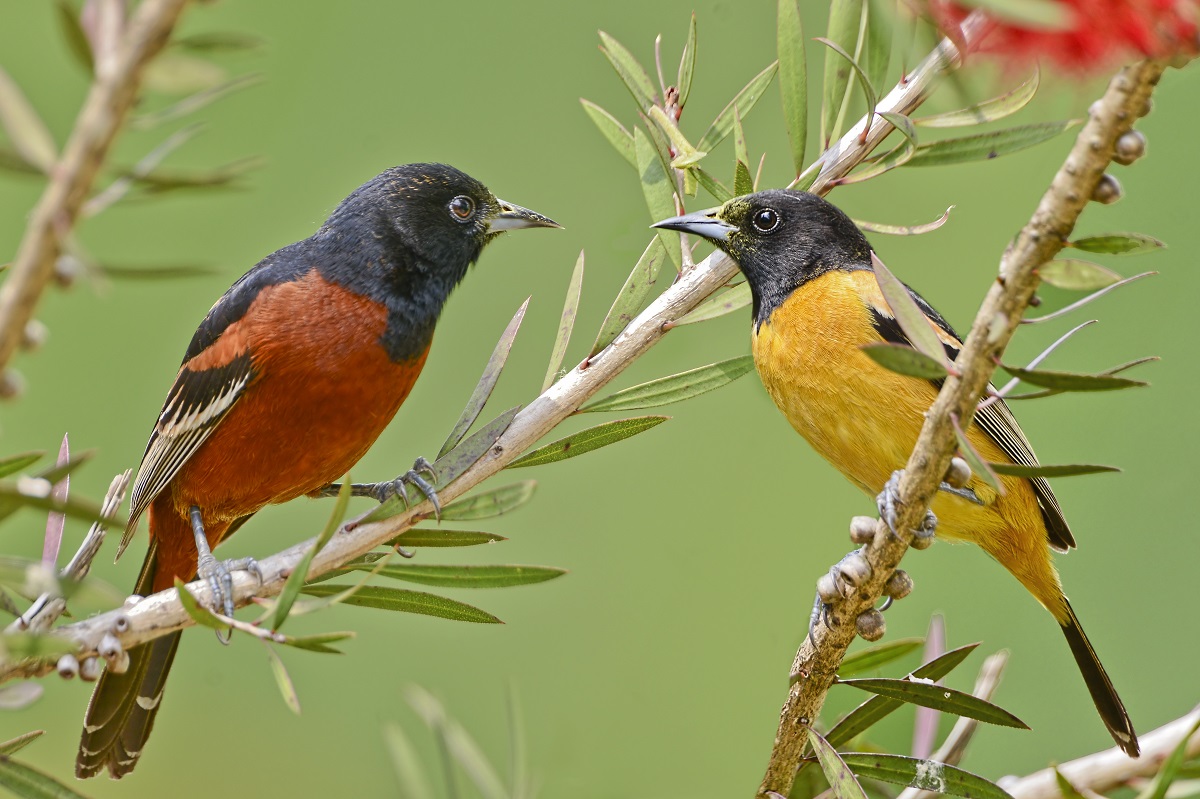Orioles are members of the blackbird family known for their bright coloring. Ten types of North American orioles found in the United States. Their name is similar to European birds of the Oriolidae family, but they are members of Icteridae family and unrelated. Pictures of orioles will help you distinguish them.
New World orioles are a North American species in the blackbird family. While they share the common name “oriole” with the Old World birds of the Oriolidae family, the two groups aren’t related at all. New World orioles belong to the family Icteridae and are technically blackbirds.
Of the 10 types of orioles covered here, the Baltimore oriole is the most well-known. Despite the Baltimore oriole being the most famous of the orioles, it’s actually the Bullock’s oriole that is the most common in North America.
We’ll share fun facts and answer common questions about both these golden orioles, along with the 8 other species of this colorful and beautiful bird.
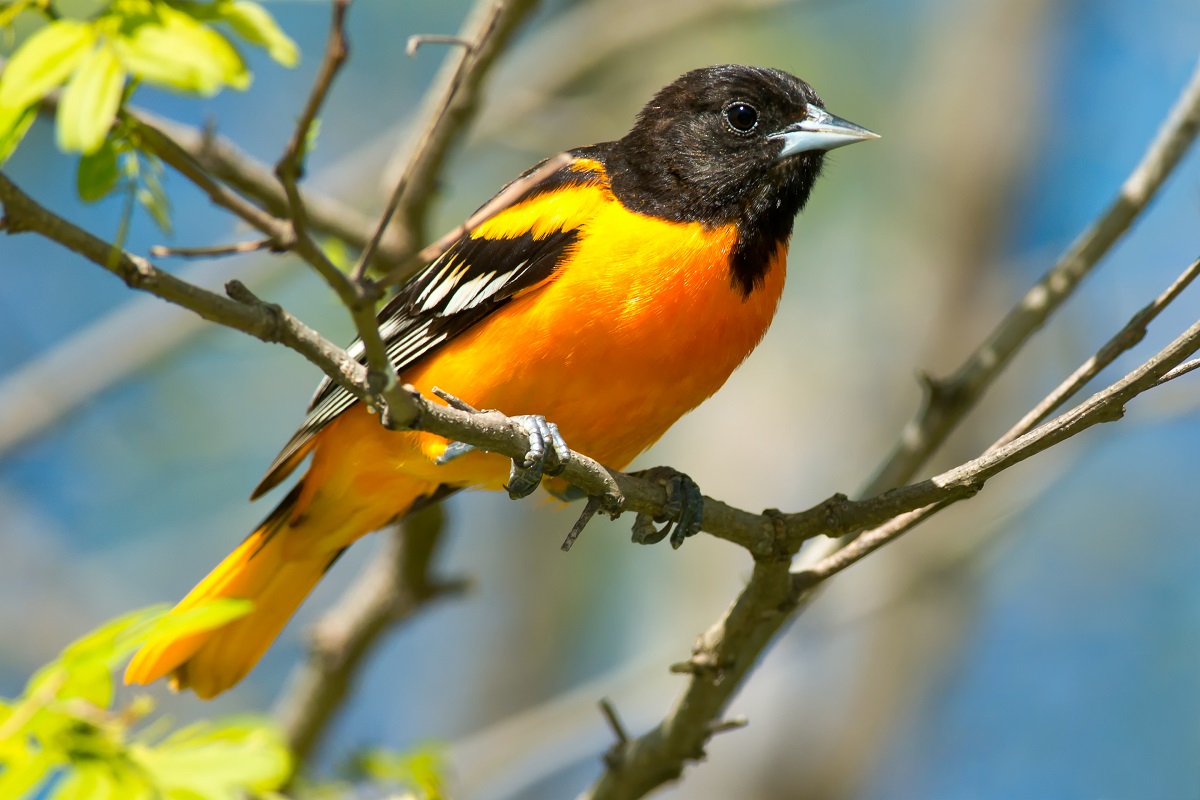
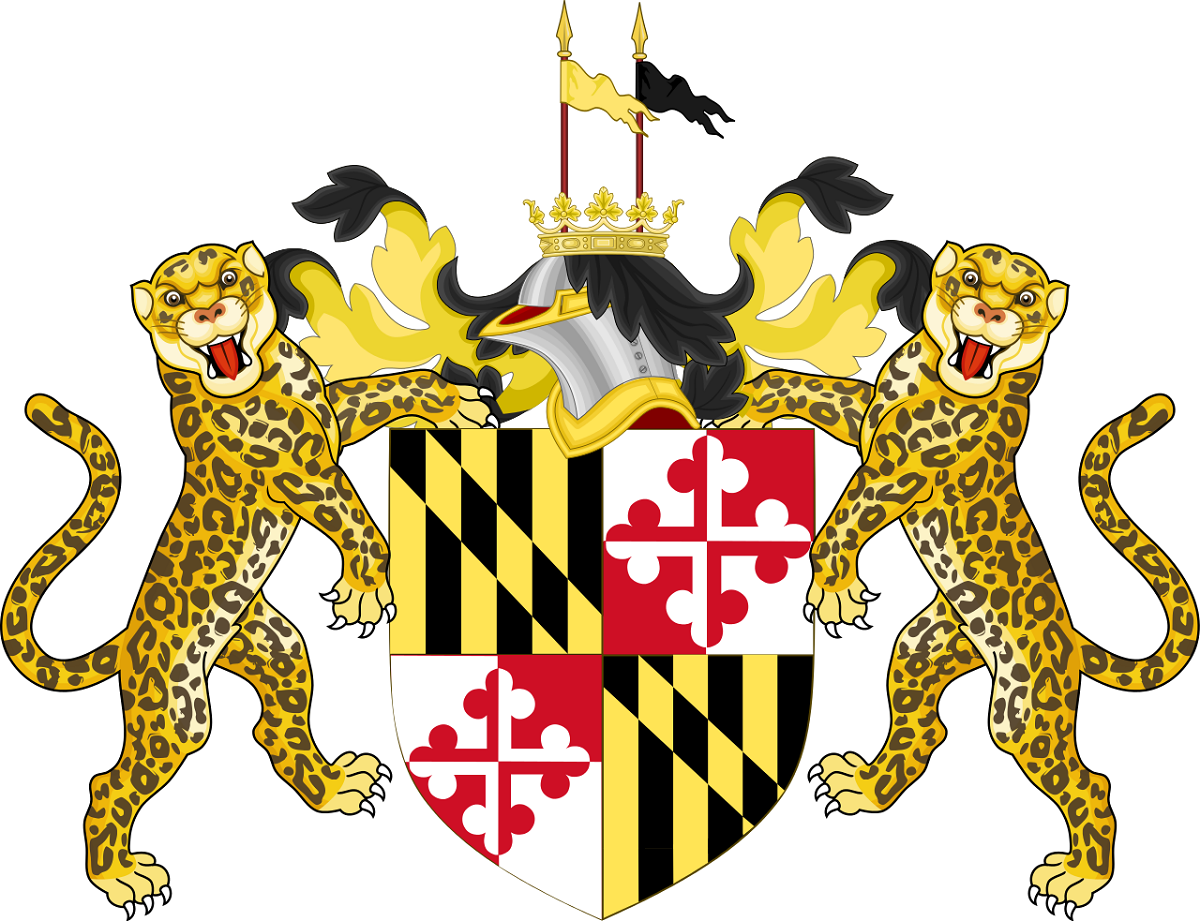
What Does A Baltimore Oriole Bird Look Like?
Adult male Baltimore orioles are orange or golden orioles with black heads, shoulders, and wings, while the females are all-over yellow birds with olive-brown wings. Both male and female Baltimore orioles have white wing bars.
Baltimore oriole birds (Icterus galbula) are found in the eastern United States, Canada, Mexico, and South America. Male Baltimore orioles like high perches in open woodlands. While adult males have the signature black and golden orange coloring, young males look like female Baltimore orioles until their second-year molt. Ironically, after several brooding cycles, females begin to look more like males when their feathers darken.
Watch our video and learn 7 things about orioles you may not have known about!
Originally named because their colors were similar to the coat of arms of Lord Baltimore, they are very well known as they are the state bird of Maryland and the namesake of the American League baseball team, the Baltimore Orioles.
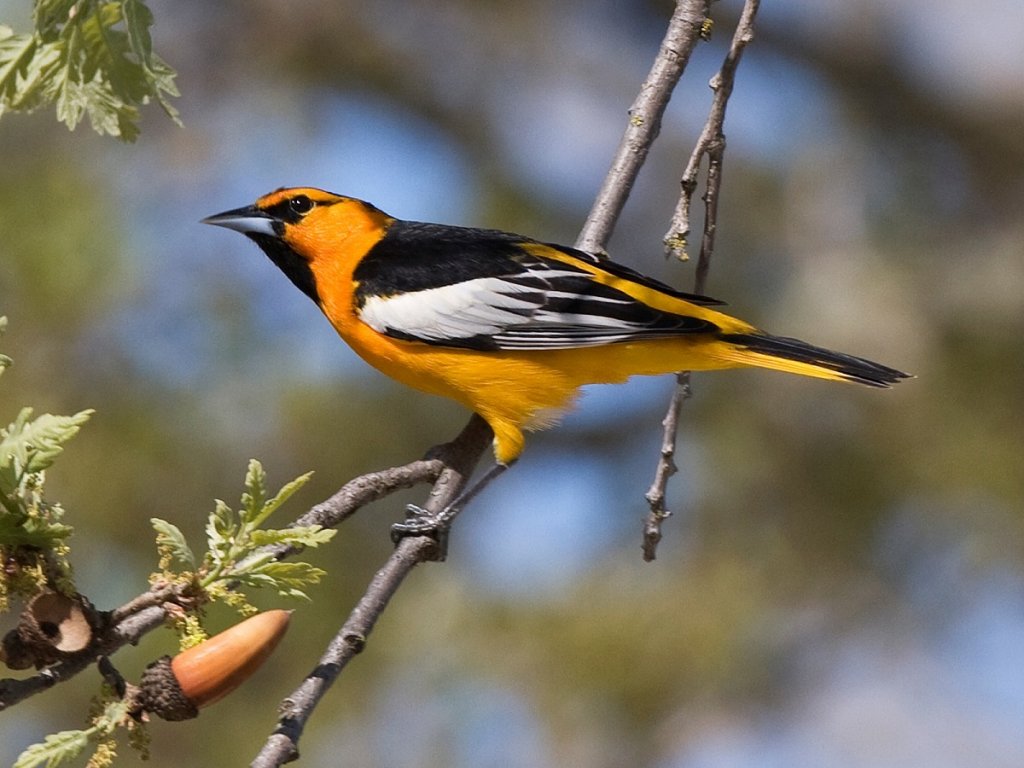
How Do You Identify A Bullock’s Oriole?
Bullock’s orioles are golden oriole birds with black crowns, eye lines, and chins. Their wings are black with large white patches. They look very similar to Baltimore orioles, but Bullock’s orioles do not have completely black heads.
Bullock’s orioles (Icterus bullockii) live in the western United States, spending their winters in Mexico. They prefer open woodland habitats near water with mature trees. During breeding season, some Bullock’s and Baltimore orioles that live in the Great Plains areas interbreed. Because of their similar appearance and interbreeding, this pair of look-a-like golden orioles was once considered a single species called the Northern Oriole.
Later research maintains that the hybrid orioles are tied to a specific region, which supports the idea that the two species are distinct.
Female Bullock’s orioles do not share the bright plumage of the males. Females are yellow with olive-brown upperparts, wings, and tails. They look very similar to female Baltimore orioles. The female Bullock’s oriole has a much longer and more prominent black eye line than her Baltimore oriole counterpart.
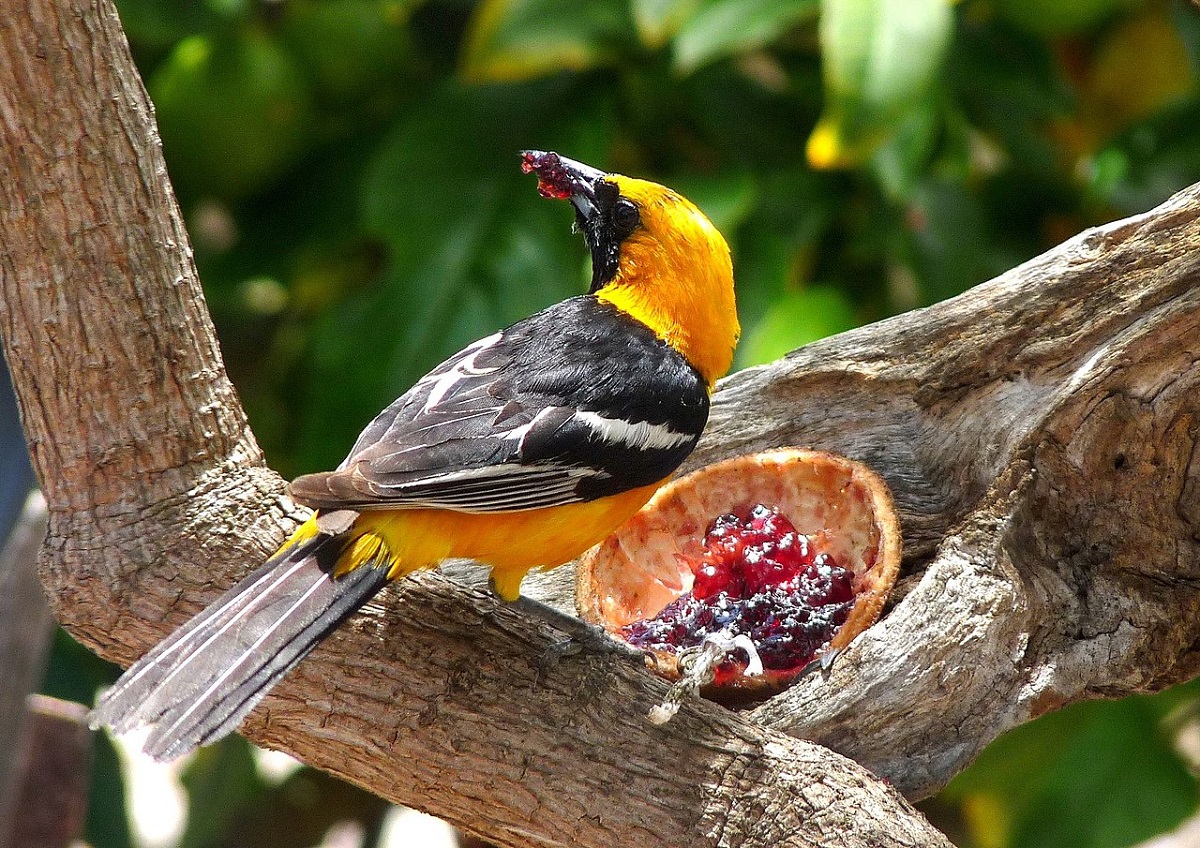
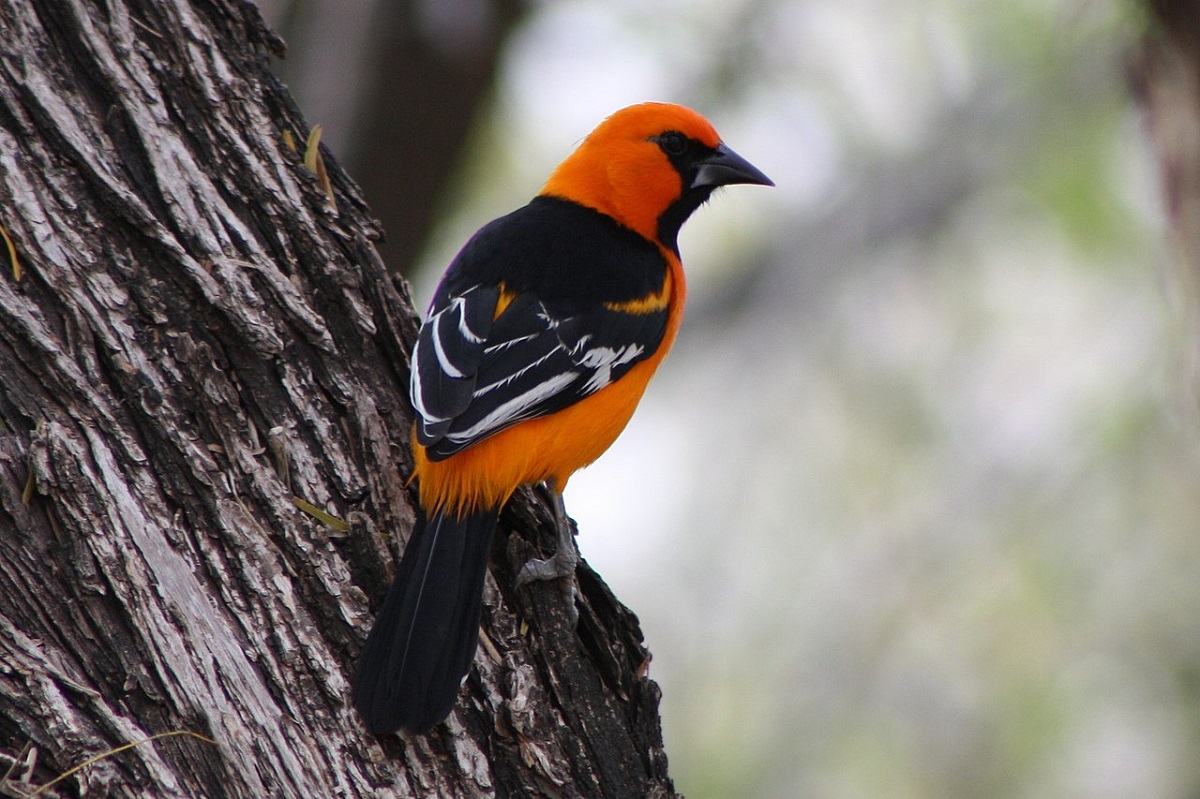
How Do You Tell The Difference Between The Hooded Oriole And The Altamira Oriole?
Altamira and hooded orioles are golden orange with black throats, face masks, wings, and tails. The most apparent difference between these two orange and black orioles is their wing bars. Hooded orioles have white wing bars with a large white bar on the shoulder. Altamira orioles have white wing bars, but the shoulder bar is bright orange instead of white.
Hooded orioles and Altamira orioles have very little range overlap between the two species. Birders in southern Texas and northeastern Mexico can use the distinctive orange bar to identify the Altamira oriole. Hooded orioles also have bright orange breasts that fade to dark yellow at the belly. Altamira orioles have bright orange underparts throughout.
Hooded orioles (Icterus cucullatus) are a migratory oriole species that go from the southwestern United States into Mexico. Females are solid yellow birds with olive wings. Adult males have black beaks, while females have lighter black to gray colored beaks.
Altamira orioles (Icterus gularis) are found year-round in coastal areas of Mexico and Central America. A small portion of their range extends into Texas’s Rio Grande Valley, where the hooded oriole can be found. Both males and females have orange bars on their shoulders. Females are lighter in color, but unlike female hooded orioles, the female Altamira oriole has a black throat and face mask.
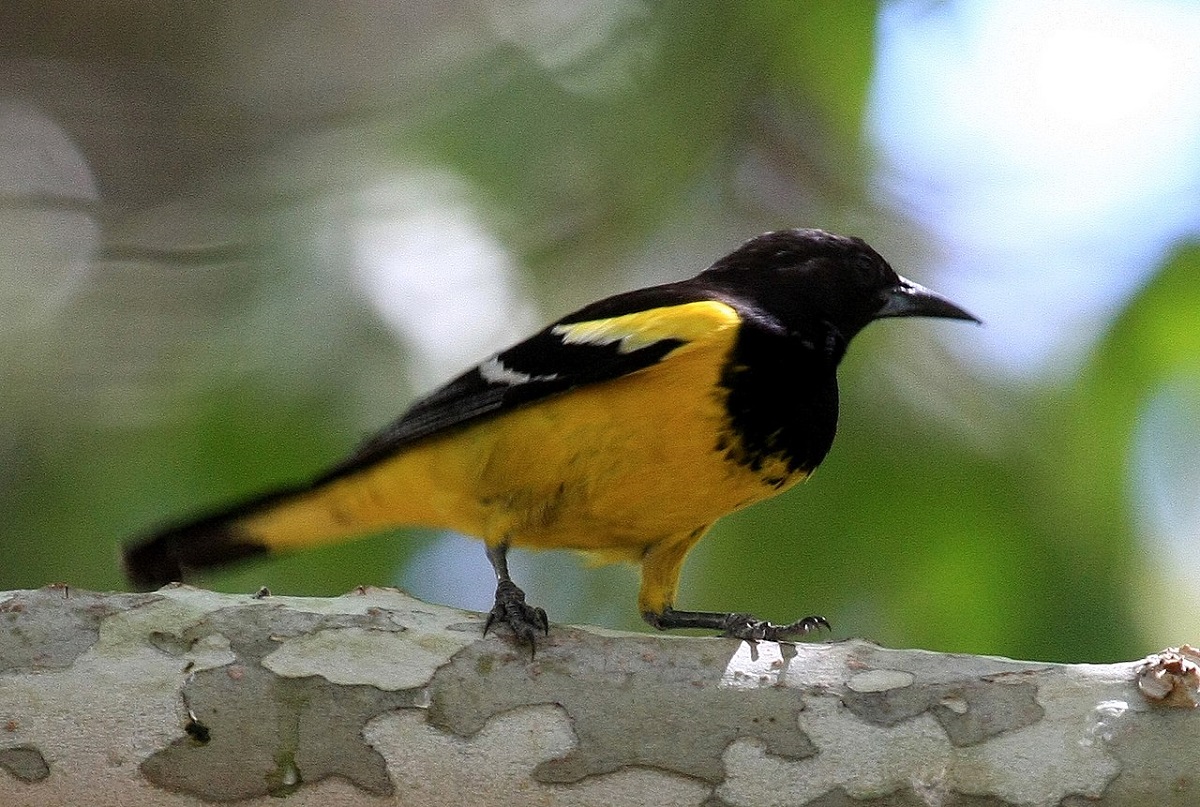
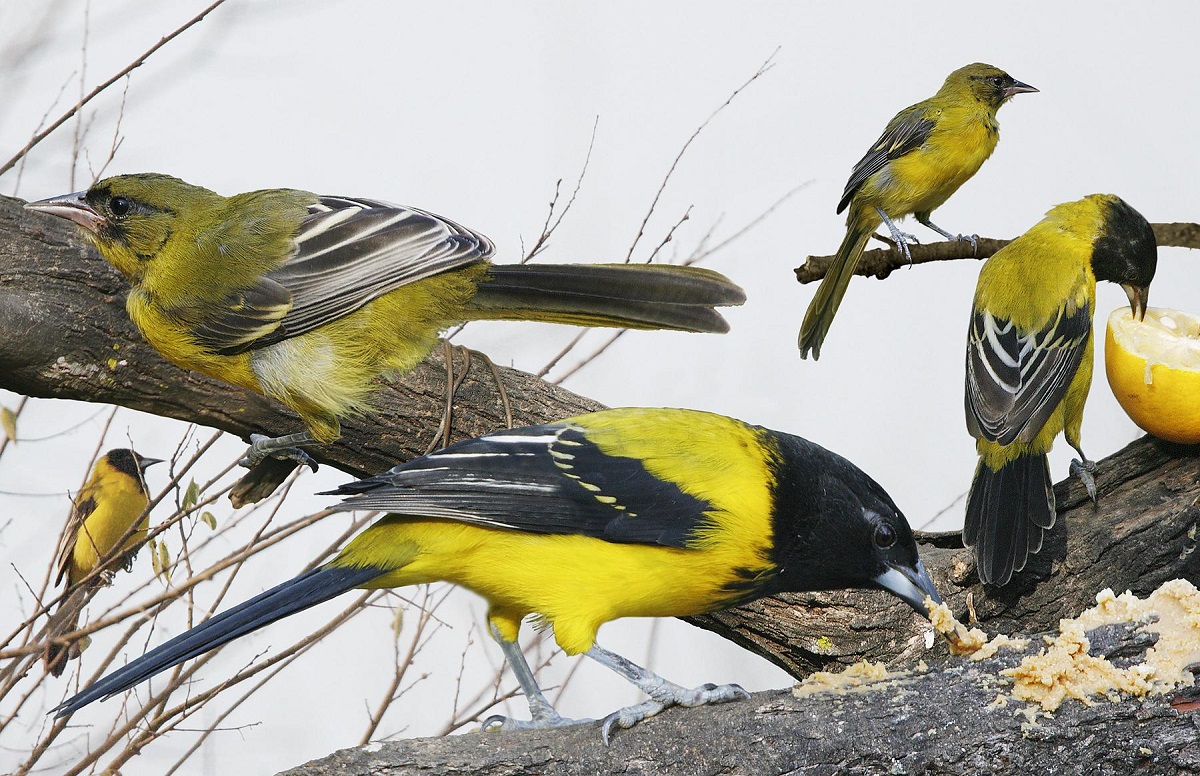
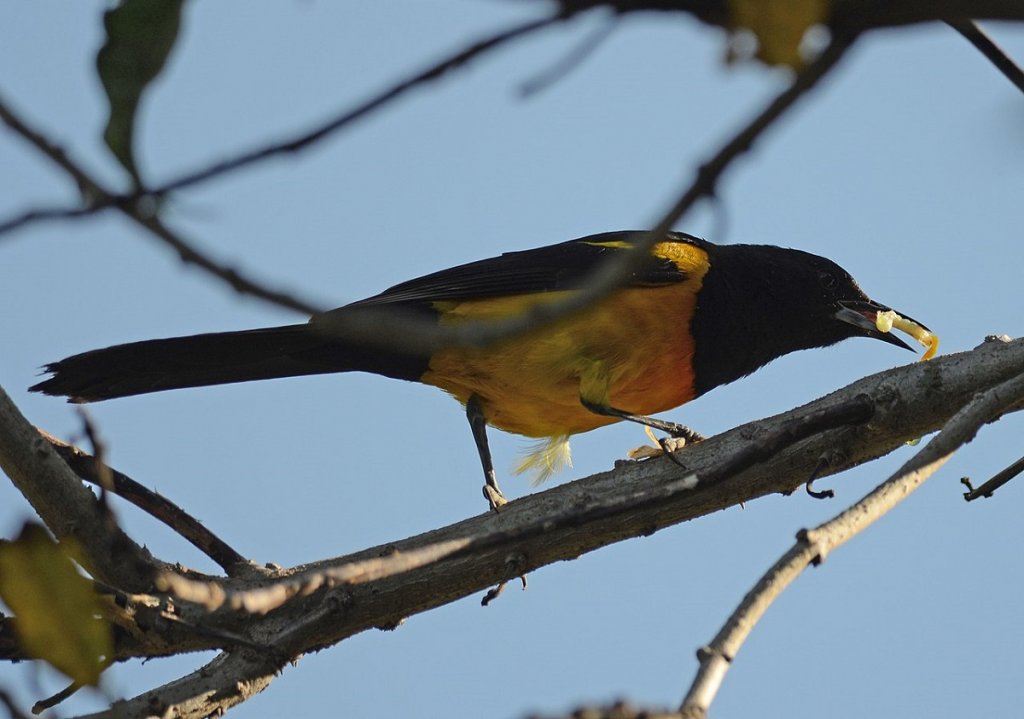
What Is The Difference Between The Scott’s Oriole, The Audubon’s Oriole, and The Black-Vented Oriole?
These 3 species of orioles are yellow birds with black heads and wings. Their wing bars are one distinguishing characteristic. Scott’s orioles have a large yellow shoulder bar with a white wing bar beneath. Audubon’s orioles have a yellow back and shoulders. The black-vented oriole has yellow shoulder bars with no wing bars.
Female Audubon’s and Scott’s orioles are similar to adult males, but their heads are olive-yellow, and their wings are olive-gray. You can tell the two females apart by their white wing bars. Female Scott’s orioles have two prominent rows on white wing bars, and the Audubon’s female has one thin white bar.
In addition to their being entirely black and yellow birds with no white bars, the black-vented oriole is the only one of these 3 similar species with a black feathered vent area. The Scott’s and Audubon’s orioles have yellow vents with black tail feathers. Adult male and female black-vented orioles look alike.
All 3 species of this black and yellow bird are found in the open woodland habitats of Mexico. The Audubon’s oriole (Icterus graduacauda) range extends into south Texas. Black-vented orioles (Icterus wagleri) are native to Mexico but have been recorded in south Texas. The Scott’s oriole (Icterus parisorum) is the only migratory bird of the three, spending breeding season in the American southwest and northern Mexico and wintering in southern Mexico and Baja California.
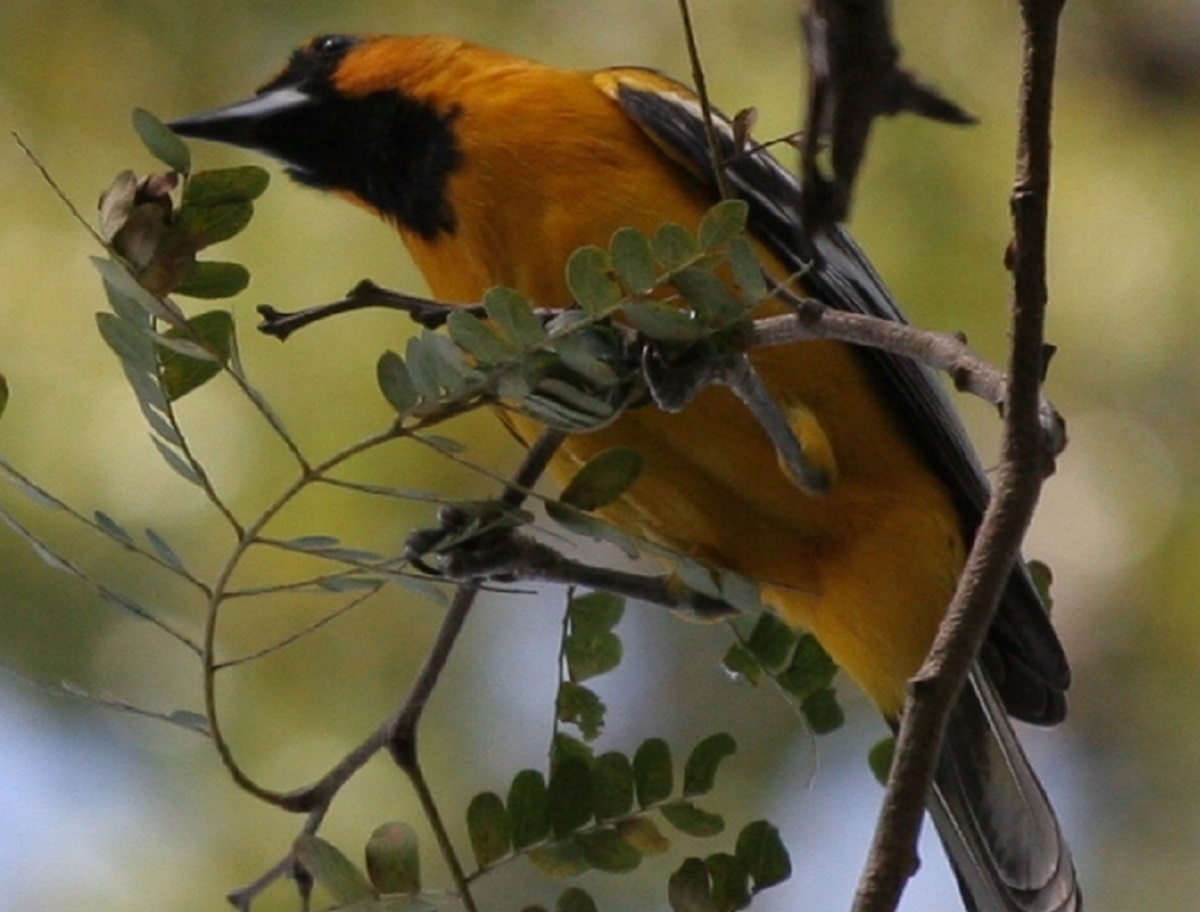
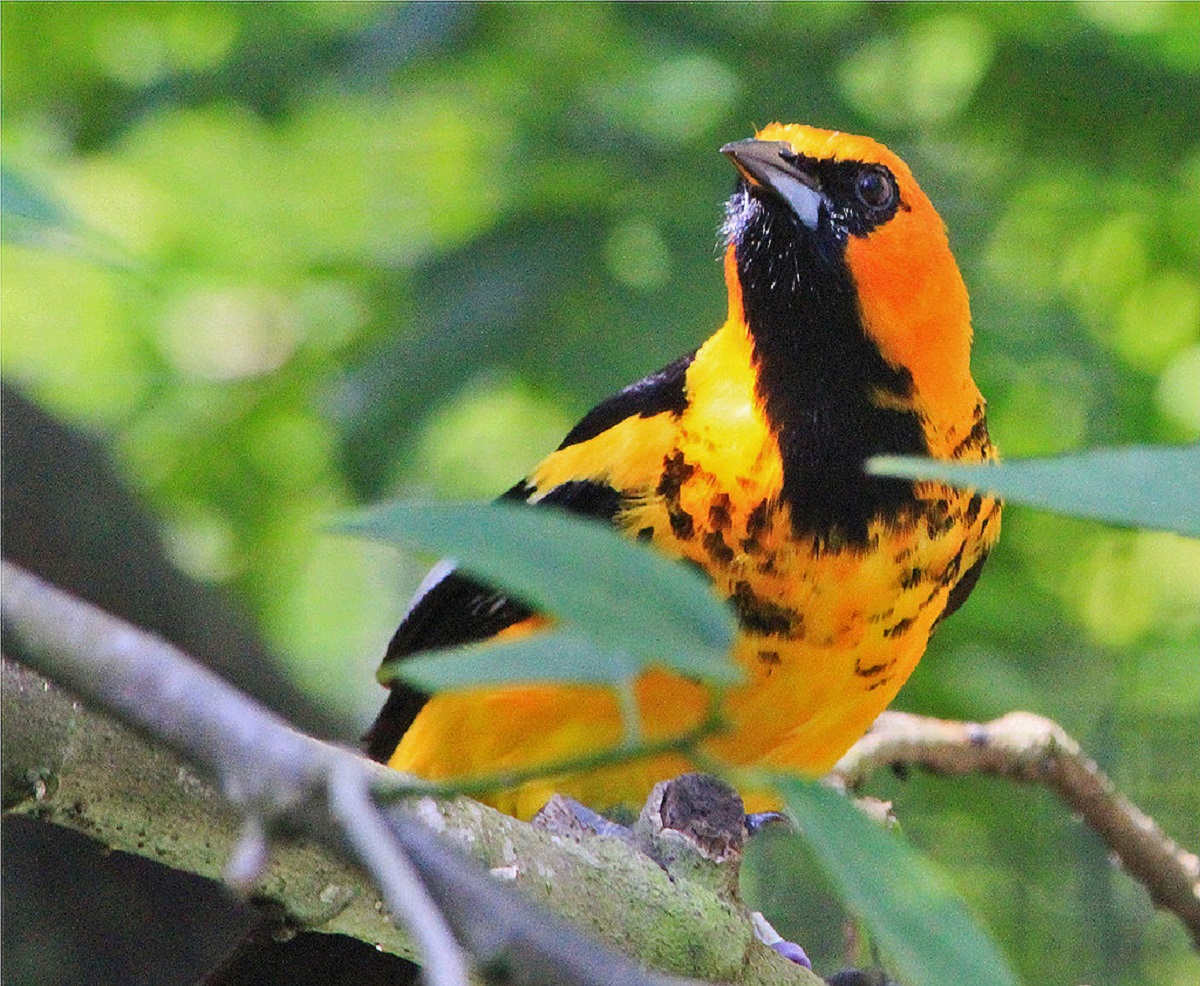
How Can You Tell The Streak-Backed And Spot-Breasted Orioles Apart?
The most notable difference between the streak-backed and spot-breasted orioles is the location of their black streaking. As their names suggest, the streak-backed oriole’s streaking is located on their back, and the spot-breasted oriole’s streaking is on their breast. Since both these orioles are found along Mexico’s Pacific Coast and in limited areas in the United States, knowing the differences between the two will help tell them apart.
The streak-backed oriole (Icterus pustulatus) has an orange head with a black face mask. The black bib is small, stopping well before the end of the throat. Along with the black streaking on golden orange shoulders, this beautiful bird has significant white barring on its black wings. While females and males look similar, immature male streak-backed orioles are more yellow in their first year than mature adults.
Spot-breasted orioles (Icterus pectoralis) have a black back with an orange bar on the shoulder and a white patch on the wing. Their black face mask extends down their throat to the center of their chest. Black spots dot a bright orange chest.
Male and female spot-breasted orioles look similar, but the female is more yellow than bright orange. Both immature males and adult females may have less spotting on their chests than adult males. Black throat patches on females are slightly narrower than on males.
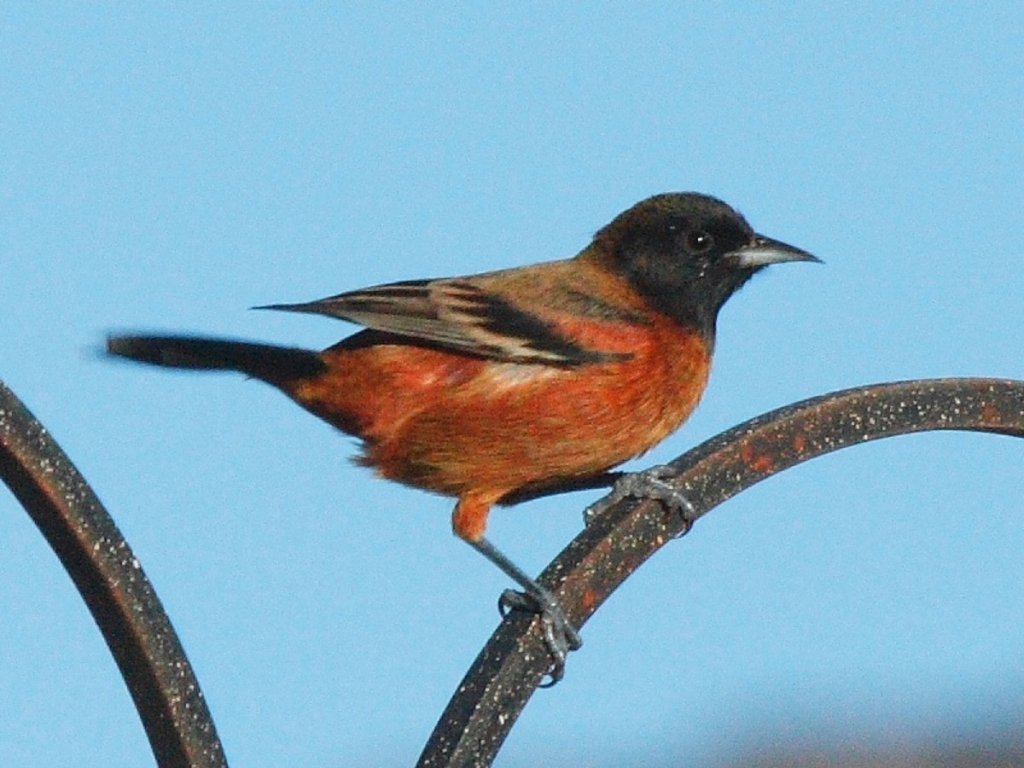
What Does An Orchard Oriole Look Like?
The orchard oriole is a black oriole with a brown chest. Orchard orioles look a lot like a barn swallow, but there are a few key differences. The orchard oriole has an all-black head and a brown bar on its shoulder. In flight, barn swallows have a notably forked tail that orioles do not have.
The orchard oriole (Icterus spurius) is one of the more unique-looking orioles. Rather than yellow or gold with black markings, the orchard oriole is black and deep chestnut brown. Their black wings have thin white barring. Female orchard orioles are yellow with olive upper parts and grayish-black wings.
Orchard orioles spend breeding season in the eastern United States. During the winter, they head back to Central America and Columbia. They eat nectar and pollen, especially in orchards. While they won’t typically eat from bird feeders, orchard orioles have been known to drink nectar from hummingbird feeders.
What North American Songbird Species Look Like Orioles?
There are countless North American songbirds that look like orioles at first glance. Warblers, grosbeaks, and American Robins are all commonly confused for orioles. Being familiar with range maps and habitat preferences of local birds will help determine whether the black and yellow bird you’re seeing is an oriole or some other songbird species.
The most common songbirds mistaken for orioles come from the blackbird family as well as other perching songbird families. A few of the bird species most often confused with orioles are-
- American Robins
- Varied Thrushes
- Black and yellow colored warblers
- Black-headed and Evening Grosbeaks
- Yellow-headed blackbirds
- American Redstarts
Where Can I Find Stock Photos And Pictures Of Orioles?
Want to see what these handsome birds look like if they aren’t native to your area?
A popular site for finding pictures of New World orioles is Wikipedia, which lists and pictures 33 species. Many images are covered under a Creative Commons license and are free to view, use in articles, and print. Some pictures require attribution.
Articles about the birds may have pictures, but they are copyrighted, so they are unusable if you want to do more than look at them. You can also find stock photos of orioles online on sites like iStock, Shutterstock, and Getty Images. Vector stock photos can be found online at Vector Stock and Free Vector. Some of the images on these websites are free, while some websites have pricing based on how many images you would like.
Many online stores that sell stock photos or vector images have sales. Watch for seasonal pricing changes and bulk purchase offers. Some of these price discounts happen near holidays, but you can also learn about flash sales by signing up for email offers and updates. Educational sites like New York’s Macaulay Library also have quite a few photos and images that can be used with attribution.
Quick Oriole Facts
- Not only is the Baltimore oriole the state bird of Maryland, it’s also the name of their baseball team.
- Orioles love the color orange, and they love oranges! You can hang orange slices from tree branches to attract these beautiful birds to your backyard.
- Orioles also love grape jelly and nectar. Place bird feeders near trees to make orioles feel safe enough to venture into your yard for a quick treat!
- Honeysuckle is another favorite food. Plant honeysuckle near trees and fence lines.
- The black-vented oriole isn’t technically native to the United States. Since 1968, the black-vented oriole has been an “accidental visitor” to parts of Texas. Being a common vagrant species and a Audubon’s and Scott’s oriole look-a-like earned the black-vented oriole a spot on our list.
- While the spot-breasted oriole range is mostly confined to the Pacific Coast, you can also find a limited population living year-round in south Florida.
At first glance, these beautiful birds with gold and black markings look remarkably similar. They even share features with other songbirds both in and outside of the blackbird family. Knowing the unique identifying features of each species is the key to telling all these species of black and yellow birds apart.

